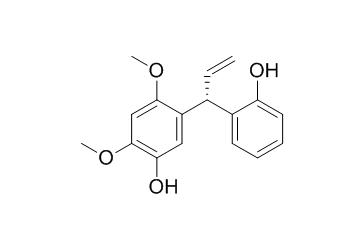Latifolin
Latifolin is a strong DPPH-scavenger, it attenuates inflammatory responses by inhibiting NF-κB activation via Nrf2-mediated heme oxygenase-1 expression. Latifolin displays potent anticarcinogenic phase II marker enzyme, quinone reductase (QR) inducing activity and high chemopreventive indices. Latifolin also shows antifungal activity against white- and brown-rot fungi.
Inquire / Order:
manager@chemfaces.com
Technical Inquiries:
service@chemfaces.com
Tel:
+86-27-84237783
Fax:
+86-27-84254680
Address:
1 Building, No. 83, CheCheng Rd., Wuhan Economic and Technological Development Zone, Wuhan, Hubei 430056, PRC
Providing storage is as stated on the product vial and the vial is kept tightly sealed, the product can be stored for up to
24 months(2-8C).
Wherever possible, you should prepare and use solutions on the same day. However, if you need to make up stock solutions in advance, we recommend that you store the solution as aliquots in tightly sealed vials at -20C. Generally, these will be useable for up to two weeks. Before use, and prior to opening the vial we recommend that you allow your product to equilibrate to room temperature for at least 1 hour.
Need more advice on solubility, usage and handling? Please email to: service@chemfaces.com
The packaging of the product may have turned upside down during transportation, resulting in the natural compounds adhering to the neck or cap of the vial. take the vial out of its packaging and gently shake to let the compounds fall to the bottom of the vial. for liquid products, centrifuge at 200-500 RPM to gather the liquid at the bottom of the vial. try to avoid loss or contamination during handling.
Plant Physiol Biochem.2023, 202:107913.
J Applied Biological Chemistry2021, 64(2):185-192
Molecules.2022, 27(7):2093.
Environ Toxicol.2024, 39(4):2417-2428.
Aging (Albany NY).2021, 13(19):22867-22882.
Genes Genomics.2020, 10.1007
Agriculture2022, 12(2),227.
Molecules2022, 27(14):4601
Mol Plant Pathol.2022, 10.1111:mpp.13280.
Korean J Dent Mater.2018, 45(2):139-146
Related and Featured Products
J Agric Food Chem. 2009 Jul 8;57(13):5707-12.
Bioactivity of latifolin and its derivatives against termites and fungi.[Pubmed:
19499920]
METHODS AND RESULTS:
Latifolin (1) and its derivatives were investigated with the aim of confirming the correlation between bioactivity (antitermite and antifungal activity) and chemical structure. Termite mortality in response to the derivatives 2'-O-methylLatifolin (2), Latifolin dimethyl ether (4), and Latifolin diacetate (5) increased 2-fold compared to compound 1. The mortality rate from 5-O-methylLatifolin (3) was not different from 1. The mass loss (feed consumption by termite) in response to compounds 3-5 was 3 times greater than compound 1, and the mass loss from compound 2 was twice as great as compound 1. The mortality rate from compounds 4 and 5 increased sharply 7 days after initial exposure. In assessing the antifungal activity of these compounds, it was found that the inhibition rates of white- and brown-rot fungi in response to all derivatives were less than that for compound 1.
CONCLUSIONS:
Our findings indicate that the phenolic hydroxyl group at C-5 of the A ring provides antitermite activities (mortality and mass loss). In addition, both C-5 and C-2' phenolic hydroxyl groups in the A and B rings have antifungal activity against white- and brown-rot fungi. In conclusion, the bioactivity of compound 1 depends upon the position of phenolic hydroxyl groups.
Arch Pharm Res. 2004 Sep;27(9):919-22.
Induction of the anticarcinogenic marker enzyme, quinone reductase, by Dalbergiae Lignum.[Pubmed:
15473661]
METHODS AND RESULTS:
The effect of an extract of Dalbergiae Lignum and four components that were isolated from the extract on the anticarcinogenic phase II marker enzyme, quinone reductase (QR), was investigated. Of the solvent extracts of Dalbergiae Lignum, the CH2Cl2 fraction was the most potent in inducing QR activity, with a CD value (the concentration required to double the QR activity) of 29.5 microg/mL. The CH2Cl2 extract was further separated into six compounds, four of which were identified as 4-methoxydalbergione, Latifolin, 4',6-dihydroxy-7-methoxyflavanone, and obtusafuran. Obtusafuran [CD = 1.1 microM; chemopreventive index (CI) = 101.9] and Latifolin (CD = 1.7 microM; CI = 154.6) displayed potent QR inducing activity and high chemopreventive indices.
CONCLUSIONS:
Latifolin and 4-methoxydalbergione were identified as strong DPPH-scavengers with half-maximal free radical scavenging concentrations of 15.9 and 17.2 microM, respectively.
Phytother Res. 2014 Aug;28(8):1216-23.
The neoflavonoid latifolin isolated from MeOH extract of Dalbergia odorifera attenuates inflammatory responses by inhibiting NF-κB activation via Nrf2-mediated heme oxygenase-1 expression.[Pubmed:
24474433]
In Korea and China, the heartwood of Dalbergia odorifera T. Chen is an important traditional medicine used to treat blood disorders, ischemia, swelling, and epigastric pain.
METHODS AND RESULTS:
In this study, we investigated the inhibitory effects of Latifolin, a major neoflavonoid component isolated from the MeOH extract of D. odorifera, on the inflammatory reaction of thioglycollate-elicited peritoneal macrophages exposed to lipopolysaccharide, with a particular focus on heme oxygenase-1 (HO-1) expression and nuclear factor-κB (NF-κB) signaling. Latifolin significantly inhibited the protein and mRNA expression of inducible nitric oxide synthase and COX-2, reduced NO, prostaglandins E2, tumor necrosis factor-α, and interleukin-1β production in primary murine peritoneal macrophages exposed to lipopolysaccharide. Latifolin also suppressed inhibitor κB-α levels, NF-κB nuclear translocation, and NF-κB DNA-binding activity. Furthermore, Latifolin upregulated HO-1 expression via nuclear transcription factor-E2-related factor 2 (Nrf2) nuclear translocation. In addition, using inhibitor tin protoporphyrin IX (SnPP), an inhibitor of HO-1, it was verified that the inhibitory effects of Latifolin on the proinflammatory mediators and NF-κB DNA-binding activity were associated with the HO-1 expression.
CONCLUSIONS:
These results suggested that the Latifolin-mediated up-regulation of HO-1 expression played a critical role in anti-inflammatory effects in macrophages. This study therefore identified potent therapeutic effects of Latifolin, which warrants further investigation as a potential treatment for inflammatory diseases.



